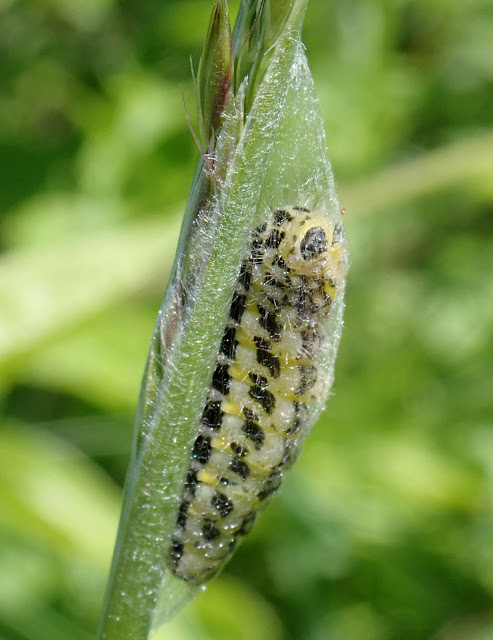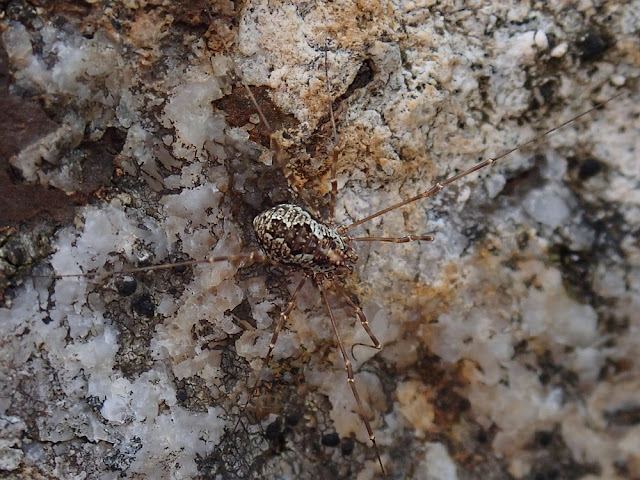June 1st: River Camel Polbrook and Caerthillian Cove, Cornwall.
A trip down to The Lizard to search for Twin-headed Clover, one we'd failed to find there on previous visits but on the way a quick stop at Polbrook to look for Diaphanous Bladder Fern and Pick-a-back Plant. One a very rare native the other a introduced species well naturalised in the area.
Diaphanous Bladder Fern - Cystopteris diaphana
Pick-a back Plant - Tolmiea menziesii
The characteristic growth of leaves which give the plant its common name
The bizarre flowers.
Shame it's an alien species and invasive in some areas.
On to Caerthillian Cove and the hands and knees search required to find the small rare clovers here.
There was a good showing of Fringed Rupturewort
Fringed Rupturewort - Herniaria ciliolata
Upright Clover - Trifolium strictum
These were mostly going over but a couple still had flowers. The Twin-headed Clover was much more difficult to spot and took over an hour to find.
Here are two flowers on the right next to an Upright Clover seed head on the left. "But it's only got one flower head" I here you say. That's right. Twin-headed Clover doesn't always have twin heads! We searched and searched but all the flowers we could find just had the one head, possibly due to the dry conditions? We only found nine flowers in all.
This flower seems to have the beginnings of a second head on the lower left. This picture shows the diagnostic glabrous upper leaves and hairy lower leaves.
Twin-headed Clover - Trifolium bocconei
A great bonus find was this gorgeous fully grown Grass Eggar caterpillar.
June 2nd: Lydford Old Railway, Devon.
The following day saw the annual pilgrimage to the BC reserve at Lydford to see Heath Fritillary (No.27). I also saw my first Small Pearl-bordered Fritillary of the year (No. 28).
Heath Fritillary
The quintessential Lydford photo.
Mating pair of Heath Fritillary on Bastard Balm.
A very heavily marked Green-veined White.
Nymph of the Forest Bug - Pentatoma rufipes
June 3rd: Dungy Head, and Ballard Down, Dorset and Martin Down, Hampshire.
A busy day with the first stop being Dungy Head near Lulworth to look for Lulworth Skipper (No. 29). I also got my first Meadow Brown of the year here (No.30)
Lulworth Skipper
Cock's-foot Moth - Dactylis glomerata
Bee Orchids on Dungy Head, Portland in the distance.
Next stop Ballard Down where I got my first Large Skipper (No.31), Small Skipper (No.32) and Brown Argus (No.33) of the year.
First Brown Argus of the year.
I didn't get photos of the skippers here
A Burnet Moth caterpillar spinning its cocoon.
Cistus Forrester.
A new species of day flying moth for me.
There were some lovely large clumps of the very small and shocking pink ...
Lesser Centuary - Centaurium pulchellum
Finally on to Martin Down where I saw my first Marsh Fritillary (No. 34) of the year and a new plant in the form of Field Fleawort.
Marsh Fritillary
Brown Argus
Large Skipper
Adonis Blue
Grizzled Skipper
Small Eggar caterpillars on larval tent
Male Wood Tiger
Corn Bunting
Field Fleawort - Tephroseris integrifolia
And finally it's always a delight to see a Burnt-tip Orchid.
June 5th: Lake District, Cumbria.
Off to the Lake district for some of the northern butterfly species. First to Latterbarrow for ...
Northern Brown Argus (No.35)
Also some fine Greater Butterfly Orchids
Then over the road to Meathop Moss for...
Large Heath (No.36)
Then in the afternoon a 'gentle stroll' up Irton Fell and Whin Rigg.
Irton Fell with Whin Rigg in the right distance
Higher up the fell looking towards Whin Rigg.
This is Mountain Ringlet country.
Mountain Ringlet (No.37)
There were lots on the wing but it was too warm to get photos (not something you often encounter in the Lake District!), If they did stop it was with wings closed like this.
Also saw my highest altitude Green Hairstreak.
Even higher up, approaching Whin Rigg which just kept getting further away!!
I was really struggling by this point and didn't really want to go to the top I kept going though.
Herdwick Sheep synonymous with the Lake District.
Wastwater from Whin Rigg
The views from the top were stunning but I wasn't sure they were worth the effort of the climb. I was even crying at one stage. It's not even a very hard climb! I think the 'writing was on the wall' as far as my hill climbing days were concerned. What did make the climb worthwhile was whilst we were sitting on one of the cairns at the summit we saw a trio of hill-topping butterflies battling for the best spots on the neighbouring cairns
A Red Admiral
And two Painted Ladies my first of the year!
Painted Lady (No.38).
June 6th: Chaple-le Dale and Southerscales, North Yorkshire.
A day of botanising in the Yorkhire Dales. First stop Chaple-le-Dale church where a naturalised colony of Kidney Saxifrage grows along the lane.
Kidney Saxifrage - Saxifraga hirsuta
View from Souther Scales towards Twistleton Scars.
Southerscales Scars a superb area of limestone pavements where we were hoping to find the rare Baneberry, which we did. Lots of it too!
It mostly grows right down inside the grykes of the limestone pavement.
Baneberry - Actaea spicata
Limestone Fern growing with Hart's-tongue Fern
Limestone Fern - Gymnocarpium robertianum
On the way back down passing through Souther Scales Farm we spotted the 'plant of the day' growing beside a derelict outbuilding. Good King Henry no less! Once quite a common plant of waysides and around farmsteads but not so these days. Well, this was the first time we'd seen it! We nearly didn't either because we'd walked straight past it on the way up. It was tricky getting photos because it was behind some high fencing which I guess was to keep sheep out of the building, rather than botanists. The exclusion of sheep is probably why it survives here. There were no plants outside of the fencing.
Good King Henry - Chenopodium bonus-henricus
June 8th: Great Orme, North Wales.
After long drive from Devon up to the Great Orme ( part of the M6 was closed) we arrived quite late in the afternoon. Even so we were successful in seeing Silver-studded Blues (No.39) and also in our attempt to see the first Grayling of the year for the UK...
.... and here it is!
Grayling (No.40)
Purple-flushed Hawkweed - Hieracium pseudoleyi
Well I think so. Probably? Or perhaps possibly?
Spotted Cat's-ear - Hypochaeris maculata
One of our bogey plants,we've been to a few places where it grows but have never actually seen it. I think we have it here but still need to see it in flower.
Before leaving we took a drive around the Marine Drive and stopped in a little quarry where the evening sun was still shining and spotted this small bush covered in roosting Silver-studded Blues. The most of these I've ever seen together. It made for some good photo opportunities too!
Lots of lovely males and some really colourful females too including...
And some nice roosting groups too!
June 9th: Snowdon, North Wales
Saturday the ninth was a fine and sunny day, which is just as well because we had booked to go up Snowdon on the railway. There's no way I could walk the whole way up! The plan was to walk back down with a couple of detours for botanising. I think the fine day probably contributed a lot but it was a real eye opener. I hadn't expected it to be quite so busy! It was the most crowded place I'd been all year!!
This was as we started to descend. We didn't bother to go to the summit as it was just too crowded. The actual summit looked like an ant's nest!! I took a photo of it from a fair distance of to show it...
... See! You can just about see the summit under the mound of people!
There were some great views from near the top as it was such a fine day.
This is where we were heading for, the cliffs of Clogwyn Coch.
Totally devoid of people and good for botanising!
Lyn Clogwyn and Parsley Fern
Parsley Fern - Cryptogramma crispa
Lesser Clubmoss - Selaginella selaginoides
There were some very nice examples of Northern Rock Cress with noticeably larger flowers than the plants we've seen in Scotland.
Northern Rock Cress - Arabidopsis petraea
And the star of the show, the plant we came all this way to see, the Snowdon Lily - Gagea serotina. Yes, we were too late, probably only by a week but all the flowers had finished. That's the chance you take though. We saw a couple of new inverts though. This moth...
Devon Carpet - Lampropteryx otregiata
Also this amazingly well camouflaged Harvestman.
Megabunus diadema
The walk back down was, erm... long!
We'd been lucky with the weather, looking back to the summit on our way down we could see the low clouds gathering.
Stay tuned. Part two coming soon...
























































































No comments:
Post a Comment